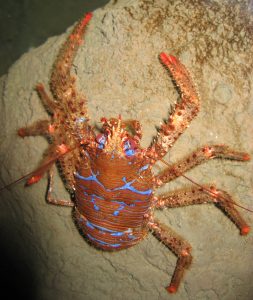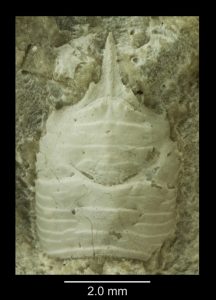
Squat lobsters of the Galatheoidea superfamily live in all oceans today, from shallow waters to depths of thousands of meters, and from hot hydrothermal vents to cold waters in the polar regions. The number of extant species is currently ~1,300 species, many of which are truly colorful. Ongoing research by biologists tell us that many more species remain undiscovered. The same applies to the fossil record of squat lobsters. Until this year, only about 200 species were known from the fossil record, starting in the Middle Jurassic.
In a new paper published in the Journal of Paleontology in May 2022, University of Alabama Museums’ Curator of Paleontology Dr. Adiel Klompmaker, UA Museums’ Research Associate Dr. Cristina Robins, and two Danish colleagues report on five new species and one new genus of squat lobster from the fossil record. Their description is based on usually tiny (<5 mm) carapaces that are diagnostic for species. The new species originate from the Jurassic of Germany, the Cretaceous of Mexico, and the Paleocene of Denmark. The new genus is described from the Eocene of Italy. Known species from the Cretaceous of Texas and Colorado, as well as the Jurassic of the Czech Republic and France, were restudied. Among them is the now reinstated oldest record of Galatheoidea to date, originating from 167 million-year-old rocks in France. Most species were found in limestones representing ancient coral and sponge reefs.

“These new species mean that fossil record of Galatheoidea has expanded by 2.5%,” Dr. Robins said. Many more species remain to be discovered in the fossil record, however. “There are many reasons to think there are many more unknown species of galatheoids undiscovered: the number of known fossil species is small compared to modern species, cryptic species may have gone unnoticed in previously described faunas as this new paper shows, and fossil squat lobster species have yet to be reported from many countries and states where we would expect them to occur, including Alabama. Since they are so small and relatively unknown, they can be frequently overlooked in larger collections or in the field,” Dr. Robins explained.

The newly published paper has been many years in the making, as is the case for many scientific papers. For example, the specimen from the Czech Republic was found by the authors in 2013 in an active quarry. Other specimens used were discovered in museum collections in the last 10 years. “This goes to show the importance of going out in the field as well exploring and maintaining museum collections,” Dr. Klompmaker said. To learn more, the scientific article can be accessed for free in the link below.
Reference
Klompmaker, A.A., Robins, C.M., Jakobsen, S.L., & Sheldon, E. (2022). Systematics of 12 Jurassic, Cretaceous, and Paleogene squat lobster taxa (Galatheoidea). Journal of Paleontology, https://doi.org/10.1017/jpa.2022.32